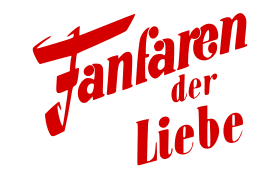Fanfares of love
| Movie | |
|---|---|
| Original title | Fanfares of love |
| Country of production | Germany |
| original language | German |
| Publishing year | 1951 |
| length | 91 minutes |
| Rod | |
| Director | Kurt Hoffmann |
| script | Heinz Pauck |
| production |
NDF , Munich ( Harald Braun ) |
| music | Franz Grothe |
| camera | Richard fear |
| cut | Claus from Boro |
| occupation | |
| |
Fanfares of Love is a German black and white film from 1951 by director Kurt Hoffmann . It's based on the same Robert Thoeren and Michael Logan story as Billy Wilder 's 1959 film Some Like It Hot .
In 1953 the sequel to Marriage Fanfares appeared .
action
The musicians Hans (bass) and Peter (piano) are looking for an engagement in various disguises. There they find out that the cyclamen chapel is looking for a reinforcement. So they dress up as women and call themselves Hansi and Petra.
They are taken over by the orchestra leader, Ms. d'Estée, who urgently warns her women about men's stories, and goes on tour with the band. Soon it becomes more and more difficult for them to keep up their disguise. On the one hand, they both fall in love with the singer Gaby, on the other hand, the hotel owner Hallinger chases after them until the dizziness is finally exposed. Finally there is a double wedding.
background
The original for the film comes from Robert Thoeren and Michael Logan , who filmed it in 1935 for a film in France under the title Fanfare d'Amour .
The film was shot from June 14th to July 1951 in the Bavaria Atelier in Munich-Geiselgasteig. The outdoor shots were taken in Berchtesgaden and Munich . Kurt Graunke and his symphony orchestra and the Max Greger band were responsible for the musical performance . Kary Barnet contributed the track I'm counting from my buttons . The premiere took place on September 4, 1951 in the Delphi Filmpalast in Berlin.
Billy Wilder took up the basic idea for his cult comedy Some Like It Hot , but described the German forerunner as "third-rate, absolutely terrible and miserable". Wilder's film is now considered one of the best film comedies ever.
Reviews
“Turbulent fluctuation with a lot of music, which advanced to the greatest German comedy success in the immediate post-war period. According to the same literary work created Fanfare d'Amour by Richard Pottier in 1935 and Billy Wilder's comedic fireworks Some like it hot 1959, which this German entertainment film can despite all the boisterous enthusiasm not nearly enough water. "
Web links
- Fanfares of Love in the Internet Movie Database (English)
- Fanfares of love at filmportal.de
Individual evidence
- ^ CineGraph - Lexicon for German-language film - Kurt Hoffmann
- ↑ Fanfares of love. In: Lexicon of International Films . Film service , accessed October 12, 2016 .
